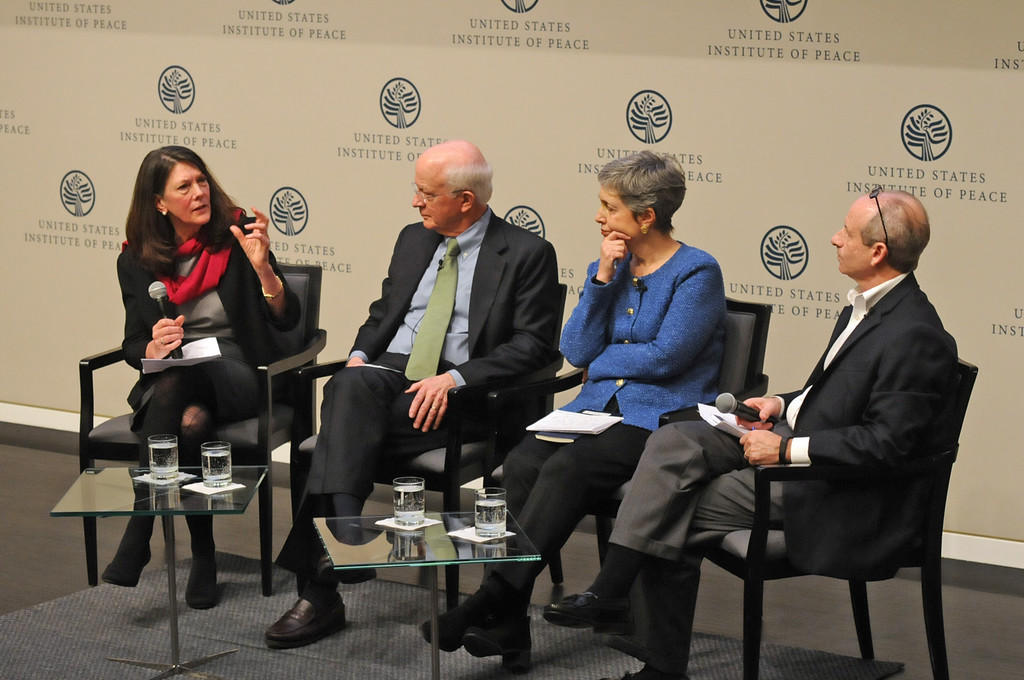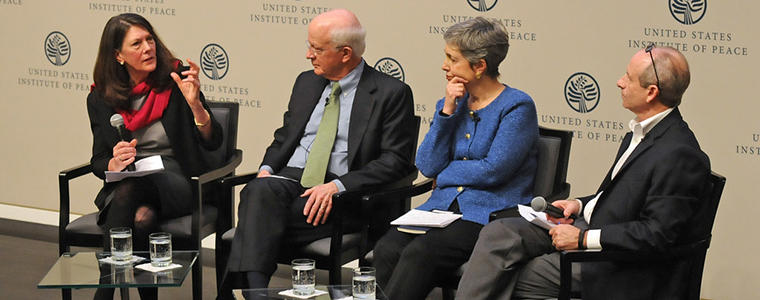Today’s global political realities of chaos and violent conflict are well-captured by the declaration, “The center cannot hold.” It’s the title of the first chapter in a new book, Managing Conflict in A World Adrift, that dissects the shifts in international security and the tense debates about how to adapt. The trends were the subject of a recent discussion at USIP that featured co-editors Chester A. Crocker and Pamela Aall and expert authors, including an award winning marine ecologist.

“I think it’s going to have to get worse before it gets better,” Crocker said of the global security trends. “We’re seeing a loss of coherence in the solving of problems, and that … means a loss of unity of action.”
Syria and Ukraine are just two of the conflicts that illustrate the trends and the complexity that explains why these wars continue unresolved. Crocker cited the questioning of established state boundaries, the uncertain relationship between governments and societies, and the overload of issues that confront decision makers in powerful and less powerful nations alike.
“We are living in a world adrift,” Crocker said. “We’re seeing an unregulated diffusion of agency, authority and responsibility to all sorts of other actors … It’s not a centralized system.”
“You get leverage and soft power by avoiding doing the wrong things.” – Chester A. Crocker
Managing Conflict in A World Adrift -- edited by Crocker, Fen Osler Hampson, and Pamela Aall -- seeks to address these puzzles, with contributions from 40 experts. Published in January by the U.S. Institute of Peace Press and the Centre for International Governance Innovation (CIGI) in Ontario, the volume is the fourth in a series. Aall, who moderated the Feb. 11 panel discussion, was the founding provost of USIP’s Academy for International Conflict Management and Peacebuilding and now is a senior advisor at USIP and a senior fellow at CIGI. Hampson, a professor at Carleton University in Ottawa, a distinguished fellow at CIGI and co-director of the Global Commission on Internet Governance, was unable to attend the discussion.
Nobel Peace Prize laureate and former President of Finland Martti Ahtisaari wrote in the book’s foreword, “As this panoramic study of contemporary conflict management makes plain, ours is a messy world, and it’s getting messier.”
The so-called “color revolutions” of the 2000s and the early days of the Arab Spring in 2011 at first appeared to be part of an evolutionary process of greater freedom, said Ellen Laipson, a contributor to the book who is president and chief executive officer of the Stimson Center, a policy research institute in Washington D.C. But most of those revolutions deteriorated into chaos or violent conflict that has stretched on for years.
“What we see is that this period of redefining state-society relations is not settled … at all,” said Laipson, who also serves on the U.S. Secretary of State’s Foreign Affairs Policy Board. “We’re seeing a lurching back and forth.”
Girls in India … and MIT
Much of the dramatic change lies in the rapid evolution of technology and its lightning-speed distribution into the hands and homes of citizens the world over, said Sheldon Himelfarb, president and chief executive officer of the PeaceTech Lab, an initiative of USIP that now operates as a separate organization.
Calling it a democratization of the field, Himelfarb said, “We are going through a complete transformation in this world of conflict management and peacebuilding” in relation to technology. He told the story of a group of 13-year-old girls in India last year who lived in the Dharavi slums of central Mumbai, the largest slums in Asia. The girls used applications-development software available online from the Massachusetts Institute of Technology to create a mobile app that would allow them and their peers, in the event of an attack on any one of them, to sound an alarm, send a message to a network of users and be located automatically. The girls then launched a crowdfunding campaign to raise money for the app.
“That’s a group of kids without any resources doing conflict prevention in their communities,” Himelfarb said. “And I’m seeing that everywhere we go, whether it’s Afghanistan or Pakistan or South Sudan. I’ve seen those kinds of entrepreneurs for social change everywhere.”
Yet just as quickly as technology evolves, evidence demonstrates daily that, in international security as in other spheres, it can be used for ill as well as good. In a chapter of Managing Conflict, Himelfarb notes how technology-enabled networks can be used just as easily by terrorists and cyber criminals.
The octopus
Marine ecologist Rafe Sagarin looks at such phenomenon as a sign of what he calls “adaptable cultures” and compares them to biological systems that adapt to their environments and conditions. In addition to crowdsourcing, examples include the Internet of things, the Air BnB community network for booking accommodation, and technology-enabled networks that allow citizens to get involved in science, rather than limiting the sphere to the academic world.
“They are all decentralized, redundant, symbiotic systems that are adaptable and solve problems in our world,” said Sagarin, program director for the University of Arizona’s Biosphere 2 research center. He advises clients like the American Red Cross and the U.S. Department of Defense, as well as corporate executives, on how adaptability can improve management in an unpredictable environment.
While decentralization has its advantages, Sagarin makes the comparison to an octopus, which also contains mechanisms for a certain degree of centralized control.
“The octopus is really more of a balanced organism that uses both the central controller and its decentralized elements to solve problems,” he said. Crocker also referenced the benefits of unity and coherence for successful conflict management and resolution. He cited the cases of the peace agreement for Mindanao in the Philippines, the peace talks between the Colombian government and the FARC guerrilla group, and the international response in the early stages of the terrorist incursions into northern Mali.
“But those are exceptions, not the rule,” Crocker said. And in recent weeks, the Philippines government of President Benigno Aquino III has struggled to keep even that peace agreement intact, according to a report in the Wall Street Journal.
In these shifting environments, the United States and other global powers find themselves in an “awkward readjustment” in relations with nations in transition, Laipson said. On the one hand, they don’t want to force their way into a struggling country with assistance that isn’t wanted. But if the teetering nation is itself in disarray and isn’t certain what assistance to request, as in the case of Libya, the aid may come too late.
The effectiveness of any intervention also can create a domino effect. The reputation of a global power influences the degree to which it can be pro-active in heading off the next conflict, Crocker said.
“You get leverage and soft power by avoiding doing the wrong things, by not creating bad precedents, [not] creating vacuums,” he said. “We can also get leverage by developing our coalition-building skills.”
Viola Gienger is a senior writer at USIP.
